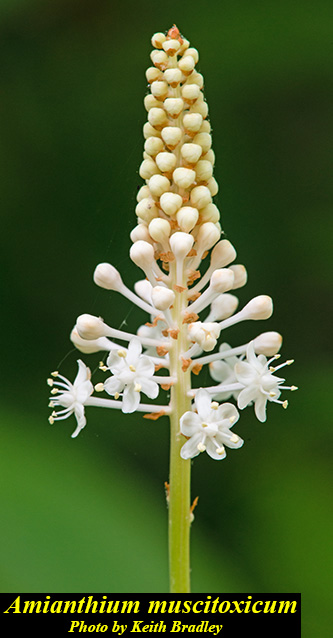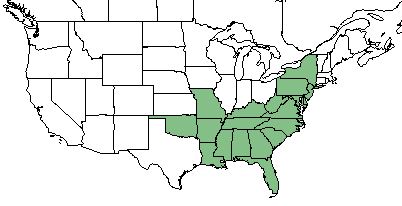Difference between revisions of "Amianthium muscitoxicum"
| Line 30: | Line 30: | ||
==Ecology== | ==Ecology== | ||
===Habitat=== <!--Natural communities, human disturbed habitats, topography, hydrology, soils, light, fire regime requirements for removal of competition, etc.--> | ===Habitat=== <!--Natural communities, human disturbed habitats, topography, hydrology, soils, light, fire regime requirements for removal of competition, etc.--> | ||
| − | < | + | ''A. muscitoxicum'' occurs from 5-1600 m in elevation across a wide variety of mesic to dry forests, pine savannas, sandhills, and meadows.<ref name="Weakley 2015"/> |
| + | |||
| + | ===Phenology=== <!--Timing off flowering, fruiting, seed dispersal, and environmental triggers. Cite PanFlora website if appropriate: http://www.gilnelson.com/PanFlora/ --> | ||
| + | In the Southeastern and mid-Atlantic United States, flowering occurs from May through July and fruiting from July through September.<ref name="Weakley 2015"/> | ||
| + | |||
<!--===Seed dispersal===--> | <!--===Seed dispersal===--> | ||
<!--===Seed bank and germination===--> | <!--===Seed bank and germination===--> | ||
Revision as of 14:11, 21 February 2018
| Amianthium muscitoxicum | |
|---|---|

| |
| Photo by Atlas of Florida Plants Database | |
| Scientific classification | |
| Kingdom: | Plantae |
| Division: | Magnoliophyta - Flowering plants |
| Class: | Liliopsida - Moncots |
| Order: | Liliales |
| Family: | Liliaceae |
| Genus: | Amianthium |
| Species: | A. muscitoxicum |
| Binomial name | |
| Amianthium muscitoxicum (Walter) A. Gray | |

| |
| Natural range of Amianthium muscitoxicum from USDA NRCS Plants Database. | |
Contents
Taxonomic Notes
Synonyms: A. muscaetoxicum; Chrosperma muscaetoxicum; Zigadenus muscitoxicus;[1]
Description
Distribution
This species occurs from southern New York, Pennsylvania, Montana, and Oklahoma, southward to the Florida panhandle, Mississippi, and Arizona.[1]
Ecology
Habitat
A. muscitoxicum occurs from 5-1600 m in elevation across a wide variety of mesic to dry forests, pine savannas, sandhills, and meadows.[1]
Phenology
In the Southeastern and mid-Atlantic United States, flowering occurs from May through July and fruiting from July through September.[1]